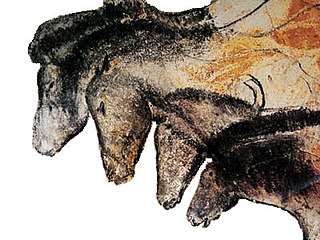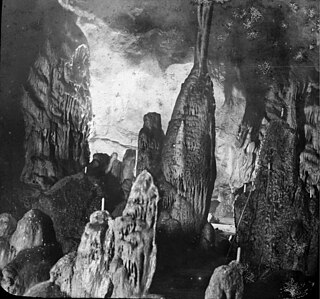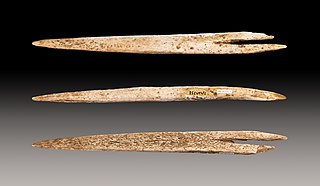 W
WThe caves of Arcy-sur-Cure are a series of caves located on the commune of Arcy-sur-Cure, Burgundy, France. Some of them contained archaeological artefacts, from the Mousterian to Gallo-Roman times.
 W
WThe Chauvet-Pont-d'Arc Cave in the Ardèche department of southeastern France is a cave that contains some of the best-preserved figurative cave paintings in the world, as well as other evidence of Upper Paleolithic life. It is located near the commune of Vallon-Pont-d'Arc on a limestone cliff above the former bed of the Ardèche River, in the Gorges de l'Ardèche.
 W
WThe Cosquer Cave is located in the Calanque de Morgiou in Marseille, France, near Cap Morgiou. The entrance to the cave is located 37 m (121 ft) underwater, due to the Holocene sea level rise. The cave contains various prehistoric rock art engravings. It was discovered in 1985 by and named after diver Henri Cosquer, but its existence was not made public until 1991, when three divers became lost in the cave and died.
 W
WThe Grotte de Cussac is a cave containing over 150 Paleolithic artworks as well as several human remains. It is located in the Dordogne River valley in Le Buisson-de-Cadouin, Dordogne, Aquitaine, France.
 W
WFont-de-Gaume is a cave near Les Eyzies-de-Tayac-Sireuil in the Dordogne départment of south-west France. The cave contains prehistoric polychrome cave paintings and engravings dating to the Magdalenian period. Discovered in 1901, more than 200 images have been identified in Font-de-Gaume.
 W
WThe Caves of Gargas in the Pyrenees region of France are known for their cave art from the Upper Paleolithic period - about 27,000 years old.
 W
WThe Isturitz and Oxocelhaya caves are an important Paleolithic site where a Neanderthal mandible was found, as well as later modern human finds associated with the Aurignacian, Solutrean and Magdalenian. They also include cave paintings and bone flutes. The caves are located in the Gazetelu hill in the Arberoue Valley in the foothills of Pyrenees, in Lower Navarre, a traditional region of the department of Pyrénées-Atlantiques, southwestern France, part of the French Basque Country.
 W
WLascaux is a complex of caves near the village of Montignac, in the department of Dordogne in southwestern France. Over 600 parietal wall paintings cover the interior walls and ceilings of the cave. The paintings represent primarily large animals, typical local contemporary fauna that correspond with the fossil record of the Upper Paleolithic in the area. They are the combined effort of many generations and, with continued debate, the age of the paintings is now usually estimated at around 17,000 years. Lascaux was inducted into the UNESCO World Heritage Sites list in 1979, as an element of the Prehistoric Sites and Decorated Caves of the Vézère Valley.
 W
WLa Marche is a cave and archaeological site located in Lussac-les-Châteaux, a commune in the department of Vienne, western France. It is an archaeological site that has engendered much debate that has not been resolved to date. The carved etchings discovered there in 1937 show detailed depictions of humans and animals that may be 15,000 years old. The cave paintings at this site, however, are controversial and many doubt their authenticity.
 W
WThe Cave of Niaux is located in the Niaux commune, Ariège département in south-western France as part of a wider geological system that includes the Sabart Cave and Lombrives Cave in the hill of Cap de la Lesse de Bialac. The Niaux cave's system is complex and has a combined length of more than 14 km (8.70 mi) of underground passages and chambers. An archaeological site with a documented history of Paleo-human presence, Niaux contains numerous distinct areas and galleries of carefully drawn and vivid wall paintings, executed in a black-outlined style typical of the classic Magdalenian period, between 17,000 and 11,000 years ago.
 W
WPech Merle is a cave which opens onto a hillside at Cabrerets in the Lot département of the Occitania region in France, about 32 km by road east of Cahors. It is one of the few prehistoric cave painting sites in France that remain open to the general public. Extending over 2 kilometres over two levels, of which only 1,200 m (3,900 ft) are open to the public, are caverns, wells and sloping tunnels, the walls of which are painted with dramatic murals dating from the Gravettian culture. Some of the paintings and engravings, however, may date from the later Magdalenian era.
 W
WThe Cave of the Trois-Frères is a cave in southwestern France famous for its cave paintings. It is located in Montesquieu-Avantès, in the Ariège département. The cave is named for the three sons of Comte Bégouen who discovered it in 1914. The drawings of the cave were made famous in the publications of the Abbé Henri Breuil. The cave art appears to date to approximately 13,000 BC.